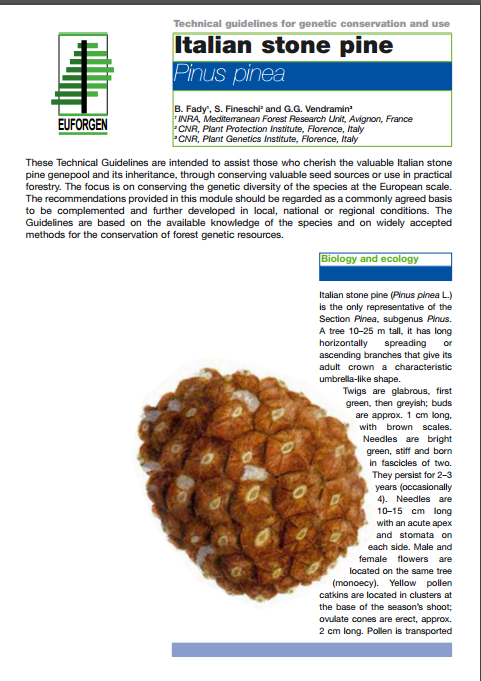Pinus pinea - Technical guidelines for genetic conservation and use for Italian stone pine
This publication has been translated into the following languages:
Italian Spanish
The conservation of forest genetic resources in the Mediterranean basin is a very complex task, as ecological and socioeconomic conditions are highly variable among countries. Because of their history of overexploitation since agriculture emerged some 10 000 years ago, assessing whether current Mediterranean forests are really well adapted and truly natural is challenging, although necessary for any careful conservation strategy.
This is the case for P. pinea, in particular. A number of scientific gaps should be filled. The past history and ecology of this species need to be understood to outline the areas of autochthony. Knowing its current adaptive diversity is also a prerequisite to outlining its potential distribution area and the consequences it may suffer from environmental changes. As in other forest tree species, implementing an in situ conservation network where selected populations are allowed to naturally regenerate without introduction of exotic material is recommended. Regions of autochthony such as Spain and the eastern Mediterranean, areas where ecological conditions are extreme (high altitude, low rainfall, high salinity etc.), and areas where extensive populations currently exist, should be the primary targets for such a network.
Appropriate silvicultural and management strategies should include the leaving of the highest possible number of seed trees before regeneration to promote maximum outcrossing and pollen flow. This might mean not cutting severely burned trees after wild fires. It should also include, in areas that are not designated for seed production, letting natural selection (rather than managed thinning) sort out young trees after regeneration. Wild fires and overgrazing being the most important risks for P. pinea forests, fire protection and social measures that might reduce these hazards should also be addressed for the effective conservation of this typically Mediterranean pine.
Authors: Bruno Fady; Silvia Fineschi; Giovanni Giuseppe Vendramin
Corporate Author: European Forest Genetic Resources Programme; International Plant Genetic Resources Instit., Rome (Italy)
Journal/Series: Technical Guidelines for Genetic Conservation and Use
Publication Year: 2004
Publication Format: Folder; PDF
ISBN: 92-9043-663-8
Language: EN
Pages: 6 p.

